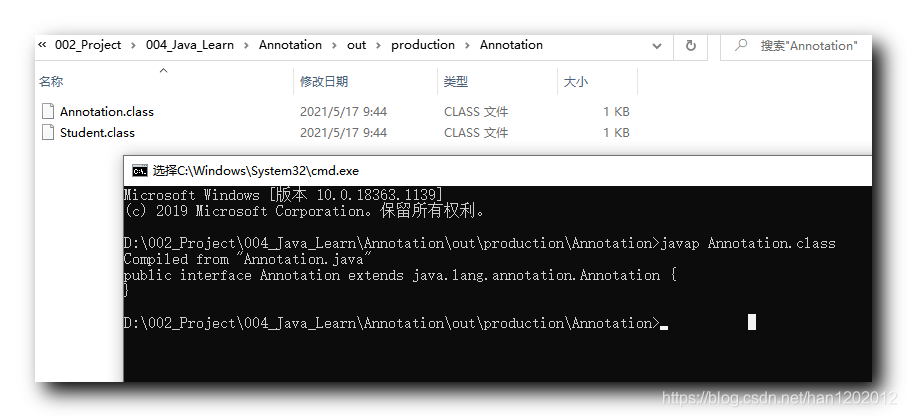【Java 注解】自定义注解 ( 注解属性定义与赋值 )
一、自定义注解格式
分析 Java 中自带的 @Override 注解 , 源码如下 :
@Target(ElementType.METHOD)
@Retention(RetentionPolicy.SOURCE)
public @interface Override {
}
- 1
- 2
- 3
- 4
注解分为两部分 :
① 元注解 ;
② public @interface 注解名称 ;
二、注解本质分析
按照 public @interface 注解名称 格式 , 写出一个注解 , 编译该注解代码生成 Annotation.class 字节码文件 ;
public @interface Annotation {
}
- 1
- 2
使用 javap 命令反编译Annotation.class 字节码文件 , 查看该注解的实际代码 ;
反编译命令如下 :
javap Annotation.class
- 1
输出内容 :
D:\002_Project\004_Java_Learn\Annotation\out\production\Annotation>javap Annotation.class
Compiled from "Annotation.java"
public interface Annotation extends java.lang.annotation.Annotation {
}
- 1
- 2
- 3
- 4

注解的本质是一个 interface 接口 , 注解接口默认继承了 java.lang.annotation.Annotation 接口 ;
public interface Annotation extends java.lang.annotation.Annotation {
}
- 1
- 2
三、注解属性及类型
注解的本质是接口 , 接口中可以定义 常量 和 方法 ;
在注解中定义 接口方法 , 就是 注解的属性 ;
为注解添加属性 : 接口中的方法都是抽象方法 , 其中 public abstract 可以省略 ;
public @interface Annotation {
public abstract String path();
}
- 1
- 2
- 3
注解属性使用格式 :
@注解名称(属性名称 = 属性值)
- 1
注解属性使用 : 在相关的代码上使用
@Annotation(path = "")
Student(String name, int age){
}
- 1
- 2
- 3
四、注解属性类型
注解属性 ( 接口方法 ) 返回值类型要求 :
① 基本数据类型 : byte , short , int , long , float , double , char , boolean ;
② 字符串类型 : String ;
③ 枚举类型 : enum ;
④ 注解类型 ;
⑤ 以上类型的数组形式 ;
注解属性返回值必须是以上的类型 , 不能设置其它类型返回值 , 否则会报错 ;
注解中定义了属性 , 在使用注解时 , 需要 给 注解属性 赋值 ;
定义 注解属性 时 , 可以 使用 default 关键字 指定属性默认值 , 下面代码中 , 制定 注解属性 intValue 值类型为 int 整型 , 默认值 88 ;
int intValue() default 88;
- 1
如果 注解属性 指定了默认值 , 在使用注解时 , 可以选择 不为该属性赋值 ( 此时使用默认属性值 ) , 也可以进行赋值 ( 指定一个新的属性值 ) ;
如果 注解属性 没有指定默认值 , 则使用 注解 时 , 必须为其指定一个默认值 , 否则编译时报错 ;
数组类型 的 注解属性 赋值 时 , 使用大括号进行赋值 , 大括号内是数组元素 , 如果只有一个属性 , 可以省略大括号 ,
注解 声明示例 :
public @interface Annotation {
/**
* 字符串类型
* @return
*/
String stringValue();
/**
* int 基本类型
* @return
*/
int intValue() default 88;
/**
* 枚举类型
* @return
*/
Number enumValue();
/**
* 注解类型
* @return
*/
Annotation2 annotationValue();
/**
* 字符串数组类型
* @return
*/
String[] stringArrayValue();
}
- 1
- 2
- 3
- 4
- 5
- 6
- 7
- 8
- 9
- 10
- 11
- 12
- 13
- 14
- 15
- 16
- 17
- 18
- 19
- 20
- 21
- 22
- 23
- 24
- 25
- 26
- 27
- 28
- 29
- 30
- 31
枚举类 :
public enum Number {
ONE, TWO, THREE
}
- 1
- 2
- 3
Annotation2 注解类 :
public @interface Annotation2 {
}
- 1
- 2
注解使用示例 :
/**
* 注解生成文档
*
* @author hsl
* @version 0.1
* @since 1.5
*/
public class Student {
/**
* 构造函数
* @param name 参数一
* @param age 参数二
*/
@Annotation(
stringValue = "tom",
enumValue = Number.ONE,
annotationValue = @Annotation2,
stringArrayValue = {"tom", "jerry"})
Student(String name, int age){
}
@SuppressWarnings("all")
@Override
public String toString() {
return super.toString();
}
}
- 1
- 2
- 3
- 4
- 5
- 6
- 7
- 8
- 9
- 10
- 11
- 12
- 13
- 14
- 15
- 16
- 17
- 18
- 19
- 20
- 21
- 22
- 23
- 24
- 25
- 26
- 27
代码分析 : 重点关注注解的使用 , 使用注解时 , 需要给 没有默认值 的 注解属性 赋值 , 格式为 注解属性名称 = 对应类型属性值 , 如果 注解属性 有默认值 , 则
@Annotation(stringValue = "tom", enumValue = Number.ONE, stringArrayValue = {"tom", "jerry"})
- 1
五、注解属性赋值简化操作
如果 注解属性 名称是 value , 并且 注解中只有 1 1 1 个属性 , 那么在使用 注解 为 注解属性 赋值时 , 可以省略注解名称 , 直接传入 注解属性值 ;
示例 : JDK 自带的 SuppressWarnings 注解 ,
@Target({TYPE, FIELD, METHOD, PARAMETER, CONSTRUCTOR, LOCAL_VARIABLE})
@Retention(RetentionPolicy.SOURCE)
public @interface SuppressWarnings {
String[] value();
}
- 1
- 2
- 3
- 4
- 5
注解使用 : 使用 SuppressWarnings 注解时 , 直接传入 “all” 参数 , 省略了注解属性名称 ;
@SuppressWarnings("all")
@Override
public String toString() {
return super.toString();
}
- 1
- 2
- 3
- 4
- 5
满足两个条件 , 才能使用上述简化方式 ;
文章来源: hanshuliang.blog.csdn.net,作者:韩曙亮,版权归原作者所有,如需转载,请联系作者。
原文链接:hanshuliang.blog.csdn.net/article/details/116915449
- 点赞
- 收藏
- 关注作者


评论(0)